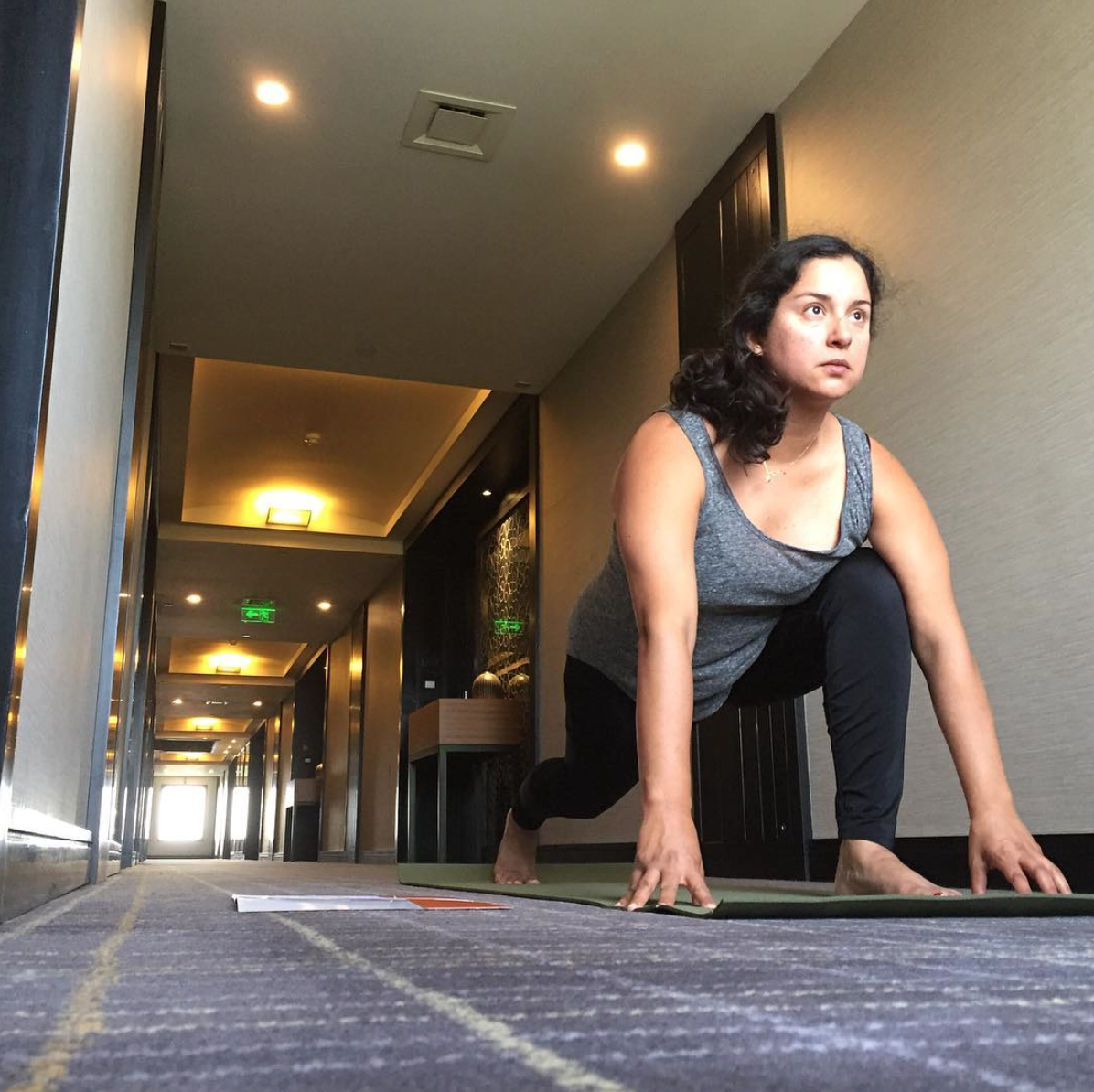What do you think about chanting?
When I was in India earlier this summer I gained a whole new understanding about two things: breathing and chanting. Last week I shared what I learned about breathing and its benefits. Today I’d like to share with you what I learned about chanting.
I first heard of chanting when I did yoga teacher training back in 2007. During a two or three hour class we learned a couple of nice chants (mantras). My favorite was the Gayatri Mantra.
And although I personally had no real challenges or objections to learning the mantras, I absolutely understand how some people might.
There is the potential concern about “singing”. People may not feel comfortable with the sound of their voice, especially in a group setting. There’s also the concern about reading and/or memorizing and pronouncing a chant that’s written in a different language (Sanskrit). There’s also the concern about not understanding exactly what it is you’re chanting. And of course the concern that the chant could potentially be some form of a prayer to a God different than your own. All legitimate concerns.
So at The Yoga Room, because we’ve wanted to be cautious to not offend or cause discomfort to any of our students, we haven’t really offered chanting, in classes or in workshops.
But what I learned in India opened my mind to the possibility. I think I may have mentioned previously that the yoga practice that was prescribed to me at the Krishnamacharya Yoga School (KYM) had two objectives: reducing the pain in my left hip and improving my relaxation (stress management).
The combination of asana (physical yoga poses) and breathing reduced my hip pain. And the breathing and chanting have been miraculous in helping me with stress management.
The chanting I was assigned is super simple. It’s easy to understand, no need to memorize anything at all, and nothing remotely prayer-like.
The chant I was assigned is Om Shanti. Om is the sound of the universe. You can read more about the meaning of Om in this helpful article. Shanti simply means peace.
Isn’t “peace” a lovely chant for a person who is working on stress management? But the benefit is derived from more than just the word alone.
When we chant, we’re doing and experiencing a few things:
- We’re breathing in order to create sound.
- During the exhales we’re generating sound. The control and constriction required to generate sound create a slower exhale.
- We’re hearing the sound made by the voice.
- We’re feeling the vibrations made by the sound.
- We’re focusing on the creation of sound, thus we’re unable to think about/worry about any other things.
Just like the author of the Om article I linked above said, it’s easy to gain an intellectual understanding of chanting, but actual benefits can only be gained through experience.
Remember that everyone starts as a beginner; we’ve all been there. In the beginning you may struggle with short breaths, you may be unsure of your voice, but if you are persistent you will find that the duration of your breaths increases, your sound becomes stronger, and you really begin to experience the benefits of chanting.
After a few rounds you can’t help but be more focused, calm, and relaxed, and before long, you’ll be chanting in the car to maintain your peace during rush hour traffic. ;)
If chanting is something you want to try, be sure to join us for one of our Mindfulness classes starting in September. You can find a printable version of our Fall Class Schedule here. I’d love to hear your thoughts or questions about chanting! Please send me an email or post a comment!
All my best, Zelinda
P.S. In case you missed it, last week I offered a free class pass for a new-to-you class to be used during the month of September. Click here to send us a quick email if you'd like one of these free passes. Psst! It's perfect for trying out a Mindfulness class!
Oh! One more thing. Tomorrow at 2:00 pm PST, I'm doing my first Facebook Live event, where I'll be live on Facebook via video. I'll be doing a Q&A about yoga and I'll be happy to answer any questions you have, including questions about our new class schedule and even my trip to India. I'll share some exciting news, too! Click here to visit our Facebook page and make sure to like the page so you'll get a notification when we go live. And if you miss the live event, you can always check out the video later on our FB page.
I *Thought* I Knew How to Breathe
For years I had a lot of trouble with yogic breathing. The length of my breath was always really short and whenever I tried any of the more in-depth yogic breathing practices (pranayama), it felt like my chest was constrained and I was suffocating. With years of yoga experience and yoga philosophy under my belt, I knew not to worry too much about it. Instead, I focused on other aspects of yoga, specifically asana, philosophy, and meditation, and I figured I’d get around to figuring out the breathing at some point.
And that point did eventually arrive. It was my meditation practice that helped me finally figure out how to release the grip in my chest and allow deeper breaths into my lungs. It took years of consistent practice, but it was so fulfilling to figure out. I learned so much about myself and my body in the process.
But then I went to India, and I realized that these great strides that I thought I’d made in my practice were actually itty bitty baby steps.
When I went to Krishnamacharya (KYM) earlier this summer, I was assigned breathing and chanting as part of my personal practice to help me manage my stress. KYM specializes in individual private yoga therapy sessions, and each student is assigned a yoga practice for whatever issues they need to or want to address, kind of like a yoga prescription.
I have so much trust in and respect for the wisdom of the team at KYM, and I was really interested in beginning my breathing and chanting practice, but whoa, it was so hard at first.

It took about 3 days to get over that initial hump of adjusting to the new practice. But when I did, what I realized is that even though I had *thought* I was doing a good job of breathing in my practice back at home, I had unintentionally resorted to mindless, mechanical ujjayi breathing. I was inhaling and exhaling on auto-pilot. Yikes.
All that time that I’d thought I’d been really mindful, I really wasn’t. It was a bit of a blow to the ego, but at the same time a welcome lesson. Yoga is a path, and we have to learn step by step. I needed to learn the first step of mindfulness before I could advance to the second step of mindfulness.
At KYM I learned from one of my teachers that during the asana practice “The breath should not enter or exit your body without your knowledge.” Whoa, right?! If we’re being really honest, when is the last time we were aware of every. single. breath. during asana practice?
As I began to practice with this new awareness of the breath, I gained a whole new perspective of yoga.
Where in my previous practice, I had experienced improved mental focus, this new practice unveiled a whole new magnitude of mental focus. Every cell in my body and mind became a rapt audience for the exhibition of the breath.
Where in my previous practice, I had enjoyed a sense of ease in the mind, this new awareness created an immediate and profound sense of ease and contentment that I had not experienced in years, at lease since the responsibilities of adulthood and parenthood settled upon me.
I realize this all sounds a bit romanticized and incredible, but it is my true experience. I’m motivated to get on my mat by the profound sense of wellness I feel the minute I become truly aware of my breath.
As you can see, my experience at KYM had a deep effect on my practice and I’m so excited to share this new knowledge with you. I’m already integrating new instruction on breathing into my classes, and when September rolls around you can find this type of instruction in our Mindfulness classes. Please remember that all of the classes are asana-based, so in the case of the Mindfulness class, the breathing is taught within the framework of asana practice.
Please let me know if you have any questions, and if you know someone who can benefit from improved mental focus and increased ease and contentment, please forward this newsletter to them and invite them to a Mindfulness class in September.

All my best, Zelinda
P.S. In last week’s newsletter I offered a free pass so you could try out a new-to-you class in September. Unfortunately the link I set up was broken, so I'm extending the offer again. Just click here to email us and we'll send you a voucher for a free class.


